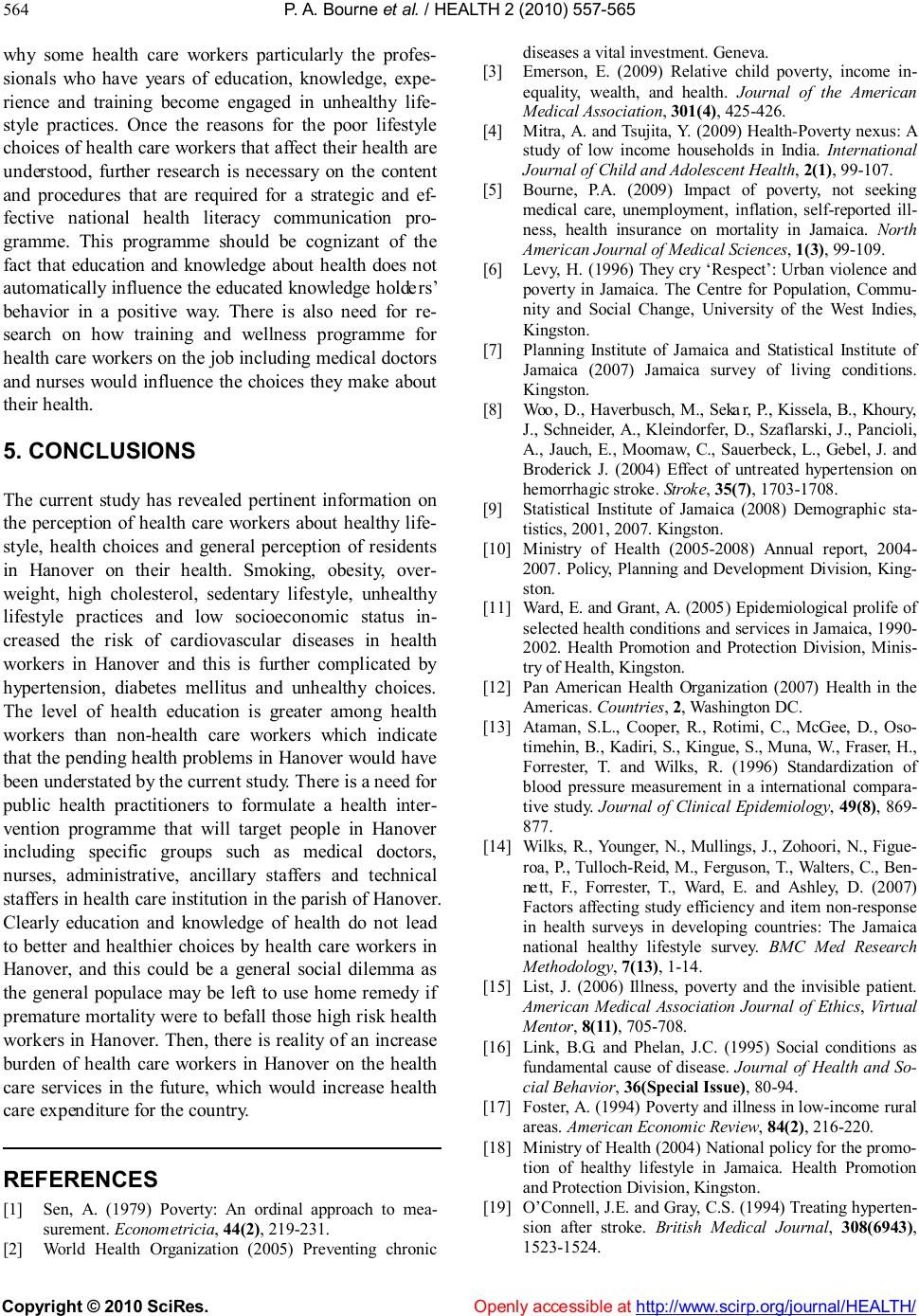
P. A. Bourne et al. / HEALTH 2 (2010 ) 557-565
Copyright © 2010 Sc iR es. Openly accessible at h ttp:/ /w ww.scirp.org / journal /HEALTH/
why some health care workers particularly the profes-
sionals who have years of education, knowledge, expe-
rience and training become engaged in unhealthy life-
style practices. Once the reasons for the poor lifestyle
choices of health care workers that affect their health are
understood, further research is necessary on the content
and procedures that are required for a strategic and ef-
fective national health literacy communication pro-
gramme. This programme should be cognizant of the
fact that education and knowledge about health does not
automatically influence the educated knowledge holders’
behavior in a positive way. There is also need for re-
search on how training and wellness programme for
health care workers on the job including medical doctors
and nurses would influence the choices they make about
their health.
5. CONCLUSIONS
The current study has revealed pertinent information on
the perception of health care workers about healthy life-
style, health choices and general perception of residents
in Hanover on their health. Smoking, obesity, over-
weight, high cholesterol, sedentary lifestyle, unhealthy
lifestyle practices and low socioeconomic status in-
creased the risk of cardiovascular diseases in health
workers in Hanover and this is further complicated by
hypertension, diabetes mellitus and unhealthy choices.
The level of health education is greater among health
workers than non-health care workers which indicate
that the pending health problems in Hanover would have
been understated by the current study. There is a need for
public health practitioners to formulate a health inter-
vention programme that will target people in Hanover
including specific groups such as medical doctors,
nurses, administrative, ancillary staffers and technical
staffers in health care institution in the parish of Hanover.
Clearly education and knowledge of health do not lead
to better and healthier choices by health care workers in
Hanover, and this could be a general social dilemma as
the general populace may be left to use home remedy if
premature mortality were to befall those high risk health
workers in Hanover. Then, there is reality of an increase
burden of health care workers in Hanover on the health
care services in the future, which would increase health
care expenditure for the country.
REFERENCES
[1] Sen, A. (1979) Poverty: An ordinal approach to mea-
sure ment. Econometricia, 44(2), 219-231.
[2] World Health Organization (2005) Preventing chronic
diseases a vital investment. Geneva.
[3] Emerson, E. (2009) Relative child po verty, income in-
equality, wealth, and healt h . Journal of the American
Medical Association, 30 1(4), 425-426.
[4] Mitra, A. and Tsujita, Y. (2009) Hea l th-P overty nexus: A
study of low income households in India. International
Journal of Child and Adolescent Health, 2(1), 99-107.
[5] Bourne, P.A. (2009) Impact of poverty, not seeking
medical care, unemployment, inflation, self-reported ill-
ness, health insurance on mortality in Jamaica. North
American Journal of Medical Sciences, 1(3), 99-109.
[6] Levy, H. (1996) They cry ‘Respect’: Urban violence and
poverty in Jamaica. The Centre for Population, Commu-
nity and Social Change, University of the West Indies,
Kingston.
[7] Planning Institute of Jamaica and Statistical Institute of
Jamaica (2007) Jamaica survey of living conditions.
Kingston.
[8] Woo, D., Haverbusch, M., Sekar, P., Kissela, B., Khoury,
J., Schneider, A., Kleindorfer, D., Szaflarski, J., Pancioli,
A., Jauch, E., Moomaw, C., Sauerbeck, L., Gebel, J. and
Broderick J. (2004) Effect of untreated hypertension on
hemorrhagic stroke. Stroke, 35(7), 1703-1708.
[9] Statistical Institute of Jamaica (2008) Demographic sta-
tistics, 2001, 2007. Kingston.
[10] Ministry of Health (2005-2008) Annual report, 2004-
2007. Policy, Planning and Development Division, King-
s ton.
[11] Ward, E. and Grant, A. (2005) Epidemiological prolife of
selected health conditions and services in Jamaica, 1990-
2002. Health Promotion and Protection Division, Minis-
try of Health, K ingst on.
[12] Pan American Health Organization (2007) Health in the
Americas. Countries, 2, Washington DC.
[13] Ataman, S.L., Cooper, R., Rotimi, C., McGee, D., Oso-
timehin, B., Kadiri, S., Kingue, S., Muna, W., Fraser, H.,
Forrester, T. and Wilks, R. (1996) Standardization of
blood pressure measurement in a international compara-
tive study. Journal of Clinical Epidemiology, 49(8), 869-
877.
[14] Wilks, R., Younger, N., Mullings, J., Zohoori, N., Figue-
roa, P., Tulloch-Reid, M., Ferguson, T., Walters, C., Be n-
nett, F., Forrester, T., Ward, E. and Ashley, D. (2007)
Factors affecting study efficiency and item non-response
in health surveys in developing countries: The Jamaica
national healthy lifestyle survey. BMC Med Research
Methodology, 7(13), 1-14.
[15] List, J. (2006) Illness, poverty and the invisible patient.
American Medical Association Journal of Ethics, Virtual
M entor , 8(11), 705-708.
[16] Link, B.G. and Phelan, J.C. (1995) Social conditions as
fundamental cause of disease. Journal of Health and So-
cial Behavior, 36(Special Iss ue), 80-94.
[17] Foster, A. (1994) Poverty and illness in low-income rural
areas. American Economic Review, 84(2), 216-220.
[18] Ministry of Health (2004) National policy for the promo-
tion of healthy lifestyle in Jamaica. Health Promotion
and Protection Division, Kingston.
[19] O’Connell, J.E. and Gray, C.S. (1994) Treating hyperten-
sion after stroke. British Medical Journal, 308(6943),
1523-1524.